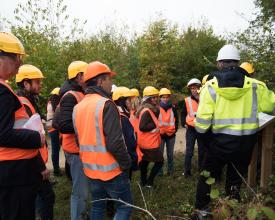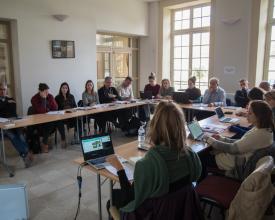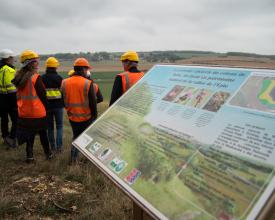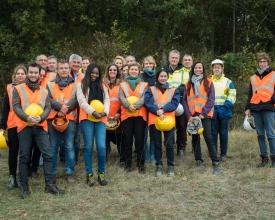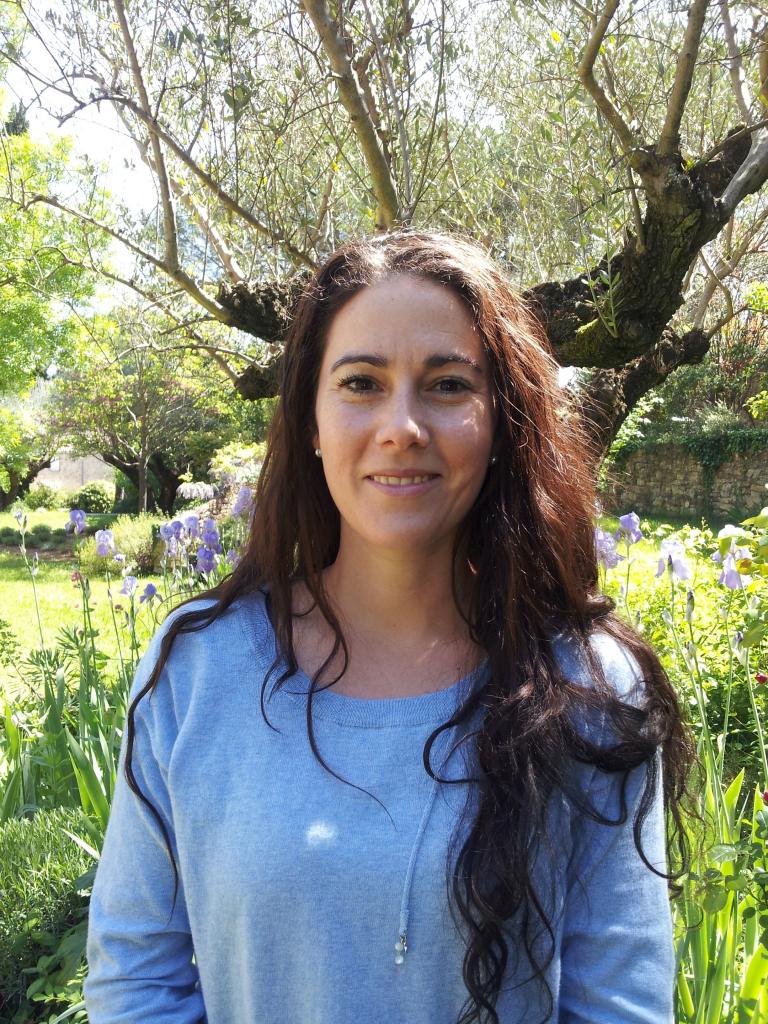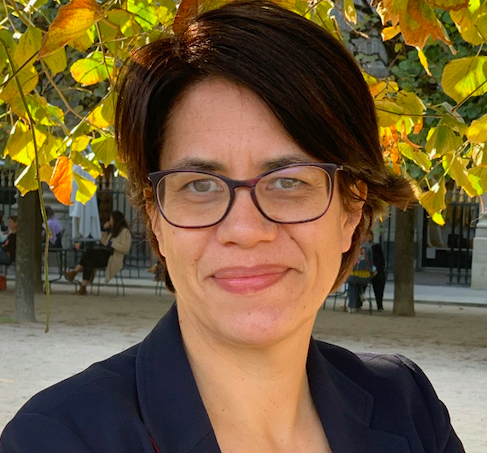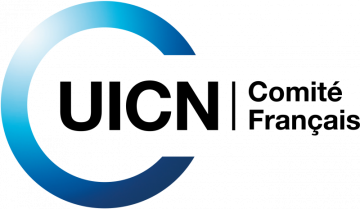
Renforcer l'engagement des entreprises en faveur de la biodiversité grâce à un groupe de travail fondé sur la confiance et la collaboration
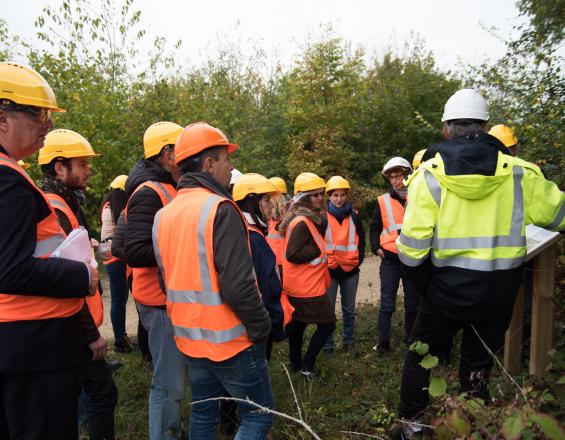
En juin 2009, le Comité français de l'UICN a créé un groupe de travail multipartite appelé "Entreprises et biodiversité" qui rassemble les membres français de l'UICN et les experts de l'UICN avec les entreprises partenaires du Comité français de l'UICN de différents secteurs (énergie, déchets et eau, cosmétiques et agrégats) afin de trouver de meilleures solutions pour la biodiversité.Ce groupe de travail contribue au développement d'études et d'outils sur différents sujets tels que la sensibilisation des employés aux questions de biodiversité, le reporting des entreprises sur la biodiversité et la gestion des espèces exotiques envahissantes sur les sites de production et au siège.
Contexte
Défis à relever
Alors que le secteur privé met de plus en plus en place des pratiques visant à réduire son impact sur la biodiversité et à restaurer les écosystèmes, il est important de l'aider à garantir et à renforcer l'efficacité de ses stratégies et de ses actions. Par conséquent, un espace de dialogue ouvert est nécessaire entre les différentes parties prenantes pour partager les points de vue, discuter et identifier les meilleures solutions pour la biodiversité.
Emplacement
Traiter
Résumé du processus
Le Comité français de l'UICN organise et réunit les membres du groupe de travail plusieurs fois par an, créant ainsi un espace de dialogue entre ses participants. Ces réunions sont l'occasion pour chaque membre (représentants d'Etat, ONG, entreprises) de partager ses opinions, ses idées, ses compétences sur les questions de biodiversité.
Les synergies qui émergent de ces échanges favorisent des évolutions efficaces vers des objectifs communs. Elles peuvent aboutir à la publication d'études et d'outils pour une meilleure prise en compte de la biodiversité par le secteur privé.
Blocs de construction
Renforcer le dialogue entre les différentes parties prenantes
Le groupe de travail sert de plateforme de dialogue pour trouver de meilleures solutions pour la biodiversité.
La présidence est assurée par les équipes françaises du Comité de l'UICN et un président est élu parmi les partenaires commerciaux pour un mandat de trois ans. Le président partage avec l'équipe de l'UICN les préoccupations des entreprises afin de garantir la pertinence de l'ordre du jour.
Le dialogue est renforcé tout d'abord par une réunion virtuelle pour convenir de l'ordre du jour annuel sur la base d'une proposition du président, puis complété par deux réunions en face à face par an. Une amélioration apportée ces dernières années a été l'organisation de visites de sites sur une base volontaire de la part de nos partenaires commerciaux afin d'apprendre les uns des autres et de confronter les pratiques à travers des actions concrètes. Cela donne un aperçu des actions reproductibles ainsi que des actions spécifiques au contexte. En fonction des besoins, davantage de réunions et d'échanges peuvent être organisés tout au long de l'année.
Facteurs favorables
-
Réunions et échanges fréquents : réunions en face à face, visites sur place, appels téléphoniques, courriels
-
Bulletin d'information bimensuel, avec un espace accordé aux membres pour partager leurs initiatives
-
Diversité des membres : scientifiques, ONG, responsables de la biodiversité dans les entreprises, responsables de zones protégées, représentants du gouvernement du ministère de l'écologie, représentants de la nouvelle agence gouvernementale pour la biodiversité, représentants internationaux de l'UICN.
-
Confiance et transparence entre les membres
Leçon apprise
-
La confiance établie avec les partenaires commerciaux grâce à des partenariats à long terme favorise une participation fructueuse des membres du groupe de travail basée sur la co-construction.
-
Il est essentiel non seulement d'impliquer toutes les parties prenantes concernées, mais aussi d'avoir un dialogue interne à l'UICN sans les entreprises pour définir les risques et les opportunités à l'avance.
-
Il est important de désigner un point focal qui approuve l'ordre du jour des réunions et anime les discussions. Le point focal doit soutenir les initiatives des membres du groupe de travail pour mettre à l'ordre du jour leurs points de vue, leurs luttes et leurs solutions pour traiter les questions de biodiversité qui sont soulevées.
- Un groupe multipartite diversifié garantit que différents points de vue seront exprimés et que les résultats seront largement partagés et acceptés afin de co-créer des solutions. Les représentants des entreprises au sein du groupe de travail sont spécialisés dans la biodiversité. La prochaine étape consistera à inclure des membres issus de services non environnementaux, tels que le service des achats, afin d'intégrer davantage les questions de biodiversité dans l'ensemble de l'entreprise.
Collaborer dans un cadre commun
Chaque année, le groupe de travail se met d'accord sur le thème d'une étude commune, qui vise à partager les bonnes pratiques, à identifier les leviers et les obstacles afin de mieux aborder les solutions.La co-création de l'étude assure l'intérêt des membres pour les sujets discutés, garantissant ainsi leur engagement. De plus, le fait de viser des objectifs communs renforce les synergies entre les groupes de travail.
Par exemple, un groupe de travail axé sur la mobilisation des employés a identifié 11 exemples de pratiques réussies telles que l'organisation de visites de la nature sur le site, l'affichage de panneaux présentant les enjeux de biodiversité des sites opérationnels, l'organisation d'événements et de moments d'échange avec des spécialistes, l'identification d'un référent biodiversité, l'organisation de sessions de formation ou de concours.
Deux aspects fondamentaux pour mobiliser efficacement les employés ont été déterminés :
-
D'une part, l'exigence d'élaborer une démarche sociale engagée portée par le top management des entreprises (CEO) ;
-
D'autre part, l'importance de promouvoir les mesures qui mènent à l'action et de valoriser leurs expériences.
Facteurs favorables
-
Définir un cadre de collaboration par le biais d'une étude co-créée avec l'approbation de la présidence.
-
Diversité des idées et des compétences afin d'élargir le spectre des possibilités de protection et de restauration de la biodiversité et le spectre des solutions envisagées.
-
Rapports réguliers aux membres du groupe de travail sur les travaux en cours et réalisés.
Leçon apprise
-
Le fait de réunir différentes parties prenantes améliore la communication et la compréhension entre les parties prenantes intersectorielles autour d'un objectif commun. Un objectif commun peut faciliter la publication d'études et d'outils dont les membres du groupe de travail ont besoin dans le cadre de leurs activités.
-
Faire venir des intervenants extérieurs du réseau de l'UICN pour partager leur expertise sur l'étude en cours permet d'approfondir les discussions et de répondre aux questions soulevées.
Impacts
Ce groupe de travail rassemble diverses parties prenantes et produit des documents. Cette méthode de travail, basée sur la coopération et la collaboration, permet aux parties prenantes de construire des solutions efficaces et opérationnelles. Elle accélère l'intégration des questions de biodiversité dans les stratégies et les actions des entreprises.Elle permet également à chaque partie de comprendre la réalité des autres : les obstacles, les objectifs, les leviers efficaces et les ressources.
Les résultats de ses réflexions sont largement partagés afin de diffuser des solutions, des outils et des études visant à réduire les impacts sur la biodiversité.
Jusqu'à présent, le groupe de travail a publié 6 publications qui ont été largement diffusées. Les trois dernières sont les suivantes
-
Rapports et indicateurs de biodiversité des entreprises : analyse de la situation et recommandations
-
Sensibiliser et mobiliser les employés en faveur de la biodiversité
-
Espèces exotiques envahissantes sur les sites des entreprises
Bénéficiaires
Le groupe de travail réunit des membres de l'UICN (ONG et représentants du gouvernement français), des experts de l'UICN et des entreprises partenaires du Comité français (EDF, Engie, Storengy, Veolia, Primagaz, L'Occitane, HeidelbergCement France et Eqiom).

